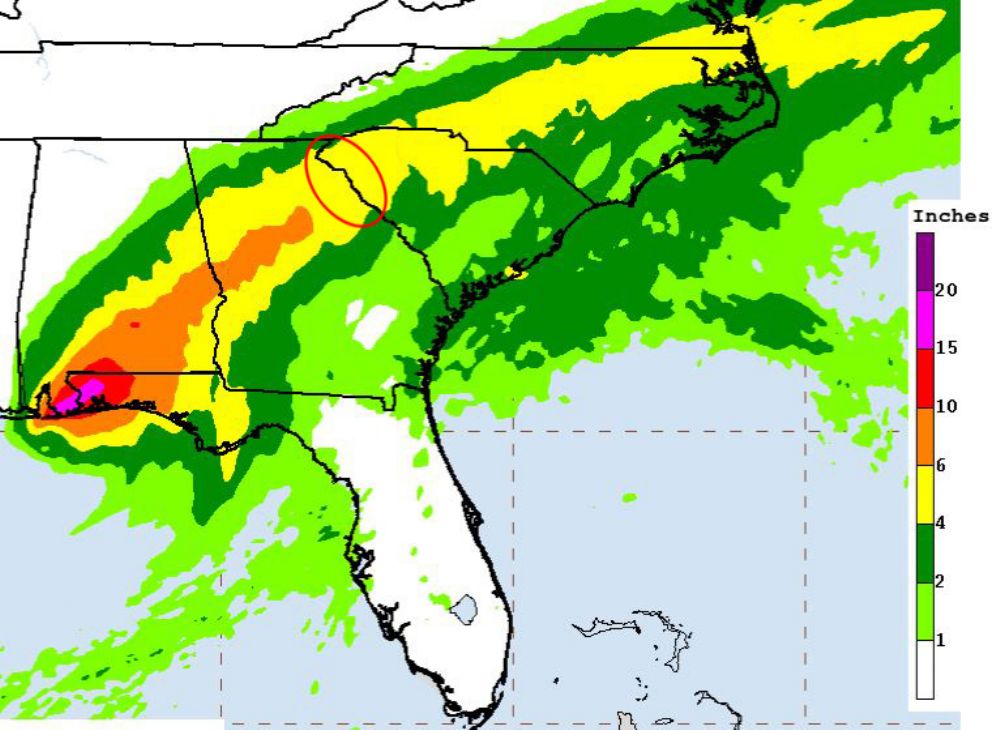After making landfall in the Gulf Coast early this morning, Hurricane Sally is expected to downgrade to a depression and move eastward soaking a wide path through Alabama, Georgia and South Carolina.
All three of our reservoirs – Hartwell, Russell and Thurmond – are in the crosshairs of the forecast, which anticipates between 4 to 6 inches of rainfall evenly across the upper basin.
Also, as of this morning, all three of our reservoirs are at full-pool levels: 660 for Hartwell, 474.6 for Russell and 329.6 for Thurmond.
In these situations, when we have full pools and the forecast is expecting large amounts of rain across the entire upper basin, people often ask if we plan to discharge water in advance to make room for rainfall.
Our answer here as in every other case has been no – no advance discharges. We do not release water in response to forecasted rainfall. There are at least three reasons for this:
First, releasing in advance of a storm adds significant uncontrolled flow to areas downriver that may also be receiving large amounts of rainfall. An early release would saturate the soil and raise the water table increasing flood risk downriver of the dams.
Second, it is inherently difficult to predict rainfall with any accuracy: Very often forecasted rainfall doesn’t materialize in the amounts expected. And given our basin’s history with drought, it would be a terrible waste to release water at the threshold of the dry season and miss the refill.
You can read about a classic example of this in 2018 when Hurricane Florence was forecasted to bring 9 inches of rain to the basin … and we observed no more than 3 inches.
Third, we designed our dams and reservoirs with a buffer zone of flood storage. Beyond their full pool levels, they are equipped with an additional five feet of storage area for flood waters.
This flood storage area provides more than 823,000 acre-feet of additional storage. That’s a huge amount of water – enough to fill up Richard B. Russell Reservoir from bottom to top.
And it’s enough to manage the forecasted 4 to 6 inches from Sally’s tropical depression. We expect to capture much of the coming rainfall in this storage area, and then gradually release the surplus downriver at non-damaging rates over a few weeks.
Another condition in our favor is that Sally’s rainfall is forecasted, not over a few hours, but over a three-day period. This mitigates the intensity of the rain, giving us more time to process inflow to the reservoirs.
But even if we observe rainfall that surpasses the flood storage capacity, our dams are further designed to manage surplus water that minimizes impacts down river. All three dams work together as a system with the ability to move water among them. When one sub-basin receives disproportionate rainfall, the others can absorb or re-distribute the impact throughout the entire system.
Finally, the spillway gates are specially designed to increase flood storage. Therefore, if we run out of our normal flood storage, our releases will be less than the natural storm flow, greatly reducing flood risk downriver.
The Savannah River Basin dams are designed to handle much greater storm events than is forecasted with Sally. They’ve handled greater events in the past, and they are well-equipped to handle the rain expected in the coming days.


 Login
Login





